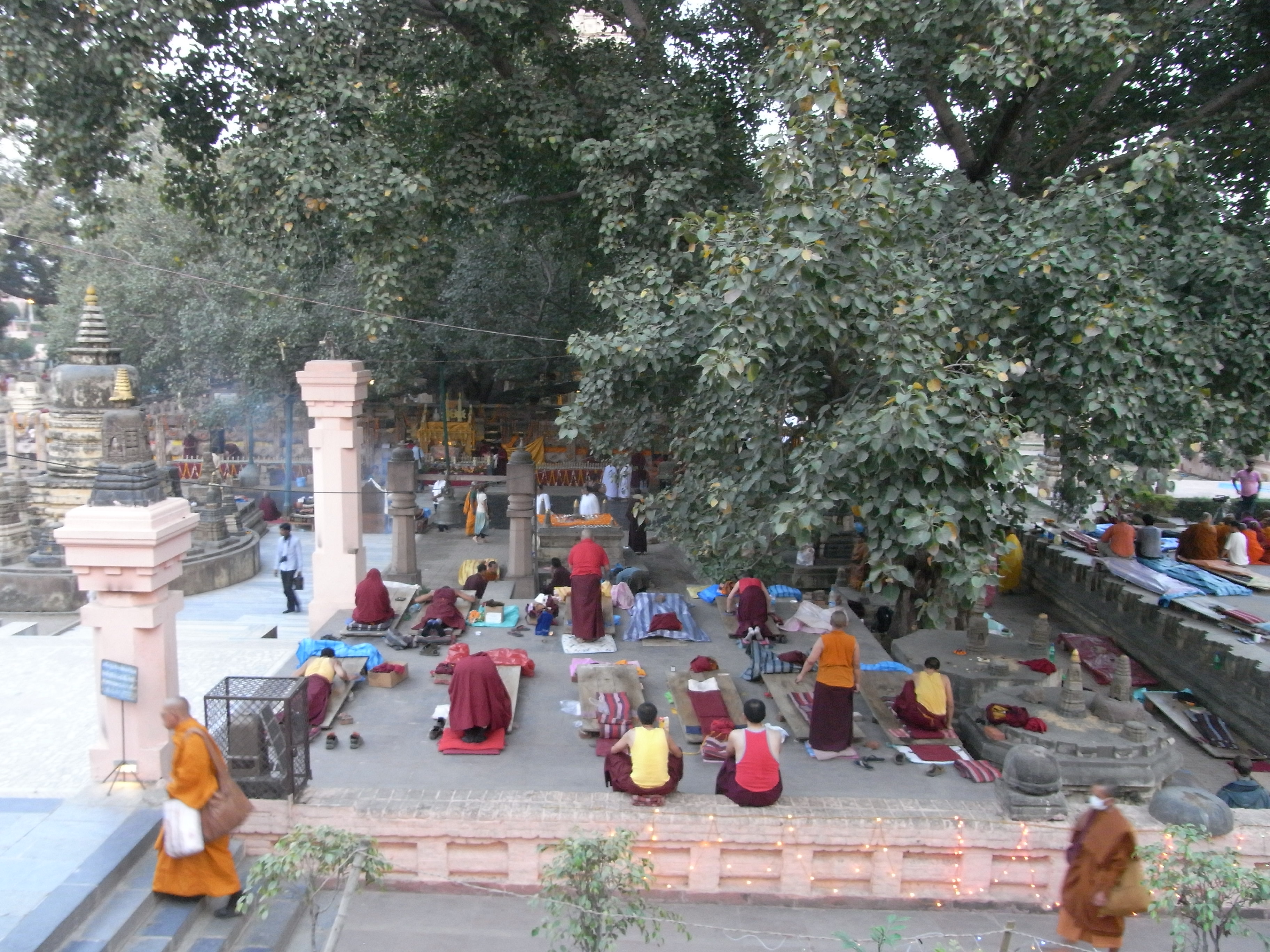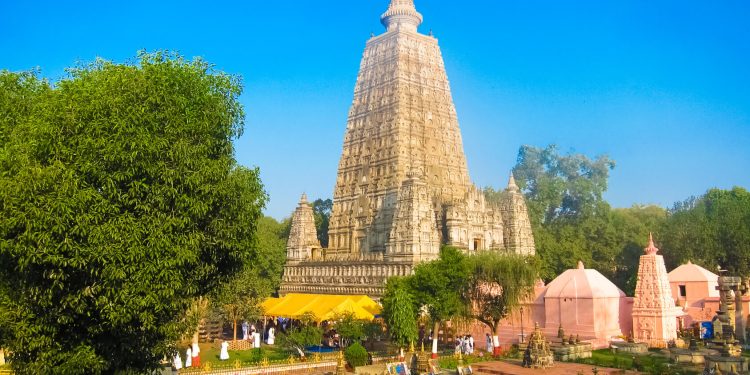The Mahabodhi (Great Enlightenment) Temple is a Buddhist stupa located in Bodh Gaya, India. The main complex contains a descendant of the original Bodhi Tree under which Gautama Buddha gained enlightenment and is the most sacred place in Buddhism. About 250 years after the Buddha attained Enlightenment, Emperor Asoka built a temple at the spot. The present temple dates from the 5th-6th century
Shrine’s History
Emperor Asoka (3rd century BC), the first Buddhist ruler of India, marked this important site with one of his trademark inscribed pillars, with an elephant capital. A stone rail was put up around the perimeter in the 1st century AD, part of which still remains. The uprights have representations of the Vedic gods Indra and Surya, and the railing medallions are carved with mythical beasts. In the 2nd century, the shrine was replaced by the present Mahabodhi Temple.
Around 400, the Chinese pilgrim Fa-hien recorded that the site contained several statues and monuments. The temple was refurbished in the Pala-Sena period (750?1200), but after that it was deserted and fell into ruin. Mahabodhi was claimed by Saivite Hindus for a time, was heavily restored by Sir Alexander Cunningham in the second half of the 19th century, and finally restored by Burmese Buddhists in 1882. In 1891, the Mahabodhi Society was founded with the aim of reclaiming Bodhgaya and the Mahabodhi temple from Hindu to Buddhist control.
The 1949 Bodhgaya Act recognise the site as a Buddhist holy place. In 2002, UNESCO declared the Mahabodhi Temple a World Heritage Site and recommended “the Indian authorities to develop an overall management plan to protect the values of the World Heritage site. Such a plan should include a provision for regular monitoring of conditions at the site, including the impact that tourism may have on the religious and spiritual significance of the place.” The Mahabodhi Temple is overseen by the Bodhgaya Temple Management Committee.

Legends Associated with This Shrine
Traditional accounts say that, in the early years of the 4th century BC, Siddhartha Gautama saw the suffering of the world and wanted to be free from it. As a young man, following the ancient traditions of Hinduism, he sought out spiritual teachers. Inquiring of their knowledge, he diligently practiced various yogas and meditations. Seven years passed, the last three in extreme asceticism, yet still he had not achieved his goal of enlightenment.
Siddhartha then journeyed toward the ancient sacred forests of Uruvela (modern Gaya in Bihar, in north India) with the intention of finally and completely realizing the infinite. Guided by visionary dreams and following in the footsteps of the Buddhas of three previous ages, Krakucchanda, Kanakamuni and Kasyapa (who had each attained enlightenment at the site) Siddhartha sat beneath the Bodhi Tree. Touching the earth, thereby calling it to witness the countless lifetimes of virtue that had led him to this place of enlightenment, he resolved not to rise again until enlightenment was attained. “Here on this seat my body may shrivel up, my skin, my bones, my flesh may dissolve, but my body will not move from this seat until I have attained Enlightenment, so difficult to obtain in the course of great periods of time”. As Siddhartha sat in deep meditation beneath the Bodhi Tree, Mara, the Dark Lord of Death, came to distract him from his endeavor. When the earth shook, confirming the truth of Gautama’s words, Mara unleashed his army of demons. In the epic battle that ensued, Siddhartha’s wisdom broke through Maras illusions. The power of his compassion transformed the demons’ weapons into flowers and Mara and all his forces fled. Three days and nights passed and Siddharthas intention was realized. He became the Buddha, meaning the Enlightened One. The Buddha then spent the next seven weeks at different places in the vicinity meditating and considering his experience. For the first week he continued sitting beneath the Bodhi tree. During the second week he remained standing while staring without interruption at the Bodhi tree. The spot where he stood is marked by the Animeshlocha Stupa, the Unblinking Stupa, which is located in the northeast of the Mahabodhi Temple complex. The Buddha is said to have walked back and forth between the location of the Animeshlocha Stupa and the Bodhi tree.
According to legend, lotus flowers sprung up along this route and it is now called Ratnachakarma, or the Jewel Walk. Following these weeks of intensive meditation, at the request of the god Indra, the Buddha began to speak of the great truths he had realized. His first sermon was given at Isipatana (modern Sarnath near Banaras). This first discourse, often called “Setting in Motion of the Wheel of Truth” presented the Four Noble Truths and the Noble Eightfold Path for which Buddhism is so famous. During the remaining 45 years of his life, the Buddha is said to have travelled in the Gangetic Plain, in what is now Uttar Pradesh, Bihar and southern Nepal, teaching a diverse range of people from nobles to poor farmers

Architectural Relevance of This Shrine
The Mahabodhi Temple is one of the earliest Buddhist temples built in brick that still survives today. The ground level of the temple is 45 meters square, stretching up in a pyramid shape that ends in a smaller square platform.
The central tower of Mahabodhi stands 180 feet (54 meters) tall. The brickwork on the outside of the temple depicts scenes from the life of the Buddha. Inside the temple is a colossal image of a seated Buddha touching the earth with his right hand (a gesture known as the earth-witness mudra). In this posture the Buddha accomplished the supreme enlightenment. The statue is of black stone but it has been covered in gold and dressed in bright orange robes.
The courtyard of the temple is studded with many smaller stupas and Buddha statues, some of which are several hundred years old. Parts of the railing that surrounds the area are among the oldest elements of Mahabodhi Temple that survive today. Immediately next to the Mahabodhi Temple is the Bodhi Tree, a descendent of the very tree under which the Buddha was enlightened, and the Jewel Walk, marking the place where the Buddha is said to have practised walking meditation for seven days after his enlightenment.

Shrine’s Map Location and How to Go There
By Road
Bodhgaya is well connected by road to Gaya (17km), Nalanda (101 km), Rajgir (78 km), Patna (135km), Varanasi (252 km), Calcutta (495km)
By Rail
The nearest railway station is Gaya(17km).
By Air
The nearest airport is at Gaya 7 Kms and Patna 135 km. Indian Airlines and Sahara Airlines connect Patna to Calcutta, Bombay, Delhi, Ranchi, Lucknow and various other cities.
Shrine Timings
5 AM to 9 PM
Events Celebrated at This Shrine
Some of the important festivals and events in Bodhgaya are Buddha Jayanti which is celebrated on a full moon day in April or May as Buddhas birth anniversary as well as enlightenment, and Nyingma Monlam Chenmo which is celebrated in January February for about three weeks. Nyingma festival is celebrated for world peace and is often attended by the Dalai Lama as well. Another special event in Bodhgaya is Buddha Mahotsava which is a three-day celebration packed with cultural and religious activities







































